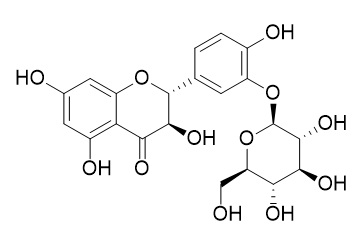Taxifolin 3'-O-glucoside
Taxifolin 3'-O-glucoside is a natural product from Chamaecyparis obtuse.
Inquire / Order:
manager@chemfaces.com
Technical Inquiries:
service@chemfaces.com
Tel:
+86-27-84237783
Fax:
+86-27-84254680
Address:
1 Building, No. 83, CheCheng Rd., Wuhan Economic and Technological Development Zone, Wuhan, Hubei 430056, PRC
Providing storage is as stated on the product vial and the vial is kept tightly sealed, the product can be stored for up to
24 months(2-8C).
Wherever possible, you should prepare and use solutions on the same day. However, if you need to make up stock solutions in advance, we recommend that you store the solution as aliquots in tightly sealed vials at -20C. Generally, these will be useable for up to two weeks. Before use, and prior to opening the vial we recommend that you allow your product to equilibrate to room temperature for at least 1 hour.
Need more advice on solubility, usage and handling? Please email to: service@chemfaces.com
The packaging of the product may have turned upside down during transportation, resulting in the natural compounds adhering to the neck or cap of the vial. take the vial out of its packaging and gently shake to let the compounds fall to the bottom of the vial. for liquid products, centrifuge at 200-500 RPM to gather the liquid at the bottom of the vial. try to avoid loss or contamination during handling.
J Ethnopharmacol.2019, 228:132-141
J Drug Target.2016, 24:1-28
J Food Biochem.2019, 43(9):e12970
Molecular & Cellular Toxicology2022, 10.1007:s13273-022-00277-3
Chemistry of Plant Materials.2019, 129-136
Journal of Functional Foods2022, 91:105019.
Separation Science Plus2022, sscp.202200048.
Plant Cell Physiol.2018, 59(1):128-141
Molecules.2023, 28(8):3490.
J Med Food.2016, 19(12):1155-1165
Related and Featured Products
Biochemical Systematics & Ecology, 2002, 30(11):1011-1022.
Flavonoids from Pinus sylvestris needles and their variation in trees of different origin grown for nearly a century at the same area[Reference:
WebLink]
METHODS AND RESULTS:
Flavonoids in needles of Scots pine planted in 1912–1914 in Poland from seeds originating from different parts of Europe, were isolated, chemically characterised and analysed by HPLC. It was shown that flavonoid profiles were similar in all tested populations and were different from those previously reported for Scots pine seedlings. They included taxifolin, Taxifolin 3'-O-glucoside, quercetin as well as quercetin 3-O-glucoside and 3′-O-glucoside. The quercetin 3-O-glucoside could be found only in a trace amount in all samples and quercetin 3′-O-glucoside appeared in all samples regardless their origin. The relative concentration of taxifolin 3′-O-glucoside, quercetin, taxifolin and total flavonoids showed dependence on the origin of seeds; needles from high latitude populations contained smaller amounts of these compounds.
CONCLUSIONS:
Presented data clearly indicate that Scots pine contain glycosidases specific for glycosylation at C-3′ rather than at C-3. Besides, they indicate that long lasting influence of similar environmental factors is not able to change genetic regulatory systems responsible for flavonoid biosynthesis.



